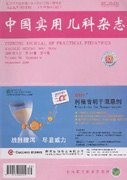Allergic rhinitis(AR) in children is non-infectious chronic inflammatory disease in the nasal mucosa which was largely determined by IgE when the body is exposed to allergens. It was believed that Th1/Th2 immune imbalance is the main pathogenesis of AR;however,more and more studies put emphasis on the integrality of individual immune system of the disease. Systematic discussion on the pathogenesis of natural immunity and acquired immunity in allergic rhinitis may provide useful AR treatments in the future.

